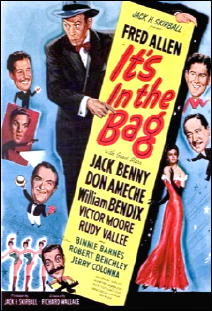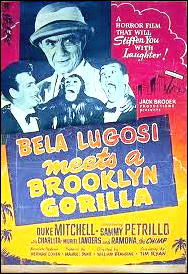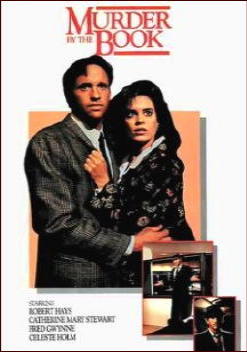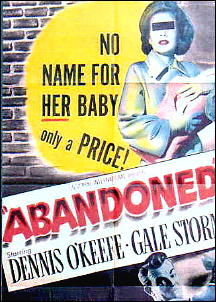October 2011
Monthly Archive
Sun 16 Oct 2011
REVIEWED BY WALTER ALBERT:
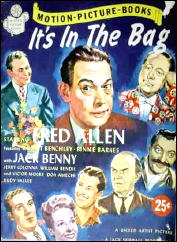
IT’S IN THE BAG. United Artists, 1945. Fred Allen, Jack Benny, William Bendix, Binnie Barnes, Robert Benchley, Jerry Colonna, John Carradine, Gloria Pope, William Terry, Minerva Pious, Sidney Toler, George Cleveland, John Miljan. (See also below.) Screen treatment: Lewis R. Foster & Fred Allen. Screenplay: Jay Dratler & Alma Reville. Director: Richard Wallace.
Alma Reville is, of course, Mrs. Alfred Hitchcock and I would like to think that some of the comic bite of this film reflects the deliciously wicked humor of the Hitchcock films.
Many of the players in this crime comedy were better known for their work in radio than in films, and I must confess that some of my least happy hours as a child were spent watching the disappointing spectacle of radio material that did not work on the screen.
This, I am delighted to report, is a happy exception to that experience, from the opening commentary by Fred Allen, as he “reads” the credits to the audience, to the satisfying conclusion.
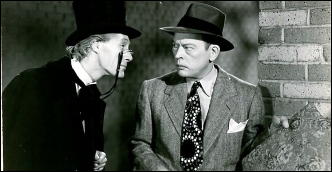
There is a gallery of funny supporting performances: William Bendix as a tender-hearted gangster leader who doesn’t like violence (he inherited the mob from his mother); Jerry Colonna as a neurotic psychiatrist; Don Ameche, Victor Moore, and Rudy Vallee joining Allen to form one of the must improbable — and worst — barbershop quartets you are ever likely to hear; Dickie Tyler as Allen and Binne Barnes’ precocious, unbearable son (with Allen’s bags under his eyes); and the unflappable Robert Benchley, who delivers a comic monologue that is one of the two comedy highlights of the film.
(His son “invented” an aquarium that he converted into a universal mouse, trap requiring some remarkable gymnastics from a gullible mouse; as Allen puts it: “Why would a mouse go to all that trouble to get a piece of cheese instead of going into a restaurant like everybody else?”)
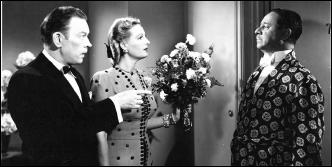
The other highlight is also unrelated to the main plot (Allen has been left a fortune by an eccentric uncle who hid the money in one of the five chairs he also left his nephew). As Allen and his family enter a movie theater to see a zombie film for which they are promised immediate seating. It very quickly becomes clear that there are no seats available, and for about ten hilarious minutes the increasingly desperate group attempts to find seats.
The film turns up occasionally on TV and I can recommend it for either prime time or late night viewing.
— Reprinted from The MYSTERY FANcier, Vol. 8, No. 4, July-August 1986.
Sun 16 Oct 2011
PATRICIA MOYES – Death and the Dutch Uncle. Holt Rinehart & Winston; hardcover, 1968. Owl, paperback, 1983. Original UK edition: Collins Crime Club, hardcover, 1968.
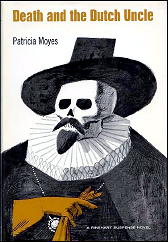
After not reading her books for years, for no good reason I can think of, I’ve recently enjoyed several of Patricia Moyes’ detective novels, coming to think of her as one of the few remaining practitioners of the old-fashioned detective novel.
As this book shows, however, she should stay away from writing thrillers, or books where Inspector Tibbett (and wife Emmy) get tangled into international intrigue.
It begins innocently enough, with the gangland slaying of a small time gambler and miscellaneous hoodlum (appropriately nicknamed “Flutter Byersâ€) in a private bar. What connection could there be between this death and PIFL (the Permanent International Frontier Litigation)? A recent squabble between two obscure African nations brings this backwater London agency into the headlines, and Tibbett surprisingly finds himself right in the thick of it.
As long as he stays in London, he seems to be on solid ground. It’s when he takes off for Holland (with wife Emmy) as part of a one-man (plus wife) effort to save one of the members of PIFL from an assassin’s bullet that that the novel began to lose its way.
Not even the mention, several times over, of Inspector van der Valk helps that much, although it does give Tibbett some sort of support in a jurisdiction the recently promoted Scotland Yard superintendent simply doesn’t have. (Van der Valk himself never makes an appearance.) And of course Emmy gets into trouble…
What I objected to even more, however, was the clumsy attempt to have a clue that means nothing to the reader (*) become a major key to the mystery. Moyes then compounds the insult by refusing to let us in on the explanation Henry gives Emmy on page 171.
A minor matter, perhaps, but after spending as much time on this case as I had up till then, I thought I deserved something more than being blown off like this.
(*) Well, unless you know Dutch, that is. I certainly don’t, and I’m also still miffed about the time it took to go back through the previous 170 pages to see if there was anybody with the name Filomeel I’d missed. (As it turns out, I did and I didn’t.)
Rating: D plus.
— This review was intended to appear in
Mystery*File 35. It was first published in
Deadly Pleasures, Vol. 1, No. 3, Fall 1993 (somewhat revised).
[UPDATE] 10-16-11. As you can tell, I felt let down by this one. What I can’t tell you is anything more about the book than this. I don’t remember it, not at all.
Let me return, though, to my first paragraph, in which I referred to Moyes as one of the last practitioners of the old-fashioned (British) detective novel. I still believe this to be true, some 18 years later, though of course there have been some contenders who have come along since then.
Kathi Maio’s 1001 Midnights review of A Six-Letter Word for Death, to be found here on this blog, agrees with this stance. On the other hand, I fear that in the same passage of 18 years, Patricia Moyes has become all but forgotten. I can’t say why, and perhaps it is not so. Opinions welcome!
Sat 15 Oct 2011
REVIEWED BY DAN STUMPF:
BELA LUGOSI MEETS A BROOKLYN GORILLA. Realart, 1952. Bela Lugosi, Duke Mitchell, Sammy Petrillo, Charlita, Muriel Landers, Al Kikume. Director: William Beaudine.
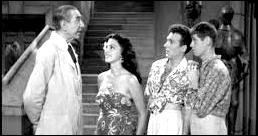
Now here is a film that single-mindedly redefines the Bad Movie Genre. Admirers of Bad Films talk glowingly of the ineptitudes of Ed Wood or the excesses of DeMille, but BLMABG is that rarity, a pure, ugly, abomination of a film, a high-concept atrocity that has few equals and no betters (or Worsers) in the ranks of Awful Cinema.
Start with the basic premise of making a Dean Martin & Jerry Lewis Picture — a dubious notion in itself. Only instead of Martin and Lewis, substitute the team of Duke Mitchell and Sammy Petrillo, who spend the film doing godawful impressions of Dean and Jerry. And until you’ve seen a really bad impression of Jerry Lewis, you just haven’t lived.
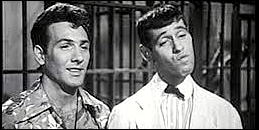
Add to this the sight of poor, palsied, Bela Lugosi, clearly a sick man by this time, clinging to the bare shreds of his career.
Throw in a comic-relief monkey, a few men in cheap Ape Suits, set the whole thing on a back-lot Tropical Island, then wrap it around a tired, tired plot of Shipwrecked Zanies and a Mad Scientist.
And you still can’t picture how bad this movie is till you see it. Unlike the films of Ed Wood, BLMABG is suffused with a thin veneer of professionalism. The sets and photography have a nice look, and there are none of the Continuity Gaps so beloved by Wood aficionados.
Somehow, though, it makes it even worse to realize that Actual Filmmakers spent there time on this.
Needless to say, I loved it.
Sat 15 Oct 2011
Posted by Steve under
ReviewsNo Comments
IT’S ABOUT CRIME, by Marvin Lachman
CAROLYN G. HART – Death on Demand. Bantam, paperback original, 1987. Reprinted many times.
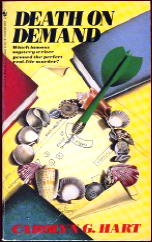
I tend to think of Death on Demand as a first book because it launched the Annie Laurance/Max Darling series. Actually, Carolyn Hart had published many books before it, some of which only appeared in Great Britain.
This is truly a mystery fan’s mystery since hardly a page goes by without a reference to a mystery author or character. Sometimes the references are perfect, as when Annie, suspected of murder and vulnerable to the killer, says she is in “a Ruth Rendell world, not St. Mary Mead.”
(Laurance is a dedicated mystery fan, as well as owner of the titular bookstore, located on a well-described island, based on Hilton Head, off the South Carolina coast. I wish she weren’t so dedicated to withholding evidence from the police, though I admit that Chief Saulter inspired no more confidence in me than he did in Annie.)
A traditionalist, Hart provides two excellent diagrams, biographies of the suspects, and a timetable. Annie even calls all the suspects, most of whom are mystery writers, together near the end, though that session ends quite untraditionally. Things do get sorted out finally in a solution that is satisfying and moderately fair to the reader.
— Reprinted from The MYSTERY FANcier,
Vol. 12, No. 4, Fall 1990 (slightly revised).
Editorial Comment: Carolyn Hart certainly struck gold when she started this series. There is nothing that mystery lovers like more than reading mysteries about their favorite choice of reading, mysteries. Number 22 in the series, Death Comes Silently, is on the schedule for next year, 2012. Follow the link in the first paragraph for a complete list.
Sat 15 Oct 2011
A 1001 MIDNIGHTS Review
by Bill Pronzini
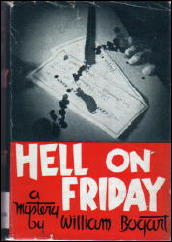
WILLIAM [G.] BOGART – Hell on Friday. Jonathan Swift, hardcover, 1941. Also published as Murder Man, Tech Mysteries, digest paperback, no date [1943?]
William G. Bogart was a prolific pulp writer in the Thirties and Forties. His chief claim to fame is that he ghosted a handful of the Doc Savage novels that have become so popular in paperback reprint. At his best, he was only a fair novelist; Hell on Friday is noteworthy primarily as one of only two mystery novels with a pulp publishing background. (The other is William P. McGivern’s But Death Runs Faster, published seven years later — a much better mystery novel but lacking the range of pulp lore and true pulpy feel of the Bogart book.)
Hell on Friday‘s protagonist, private eye Johnny Saxon, is a former “prince of the pulps” who quit writing after three years of phenomenal success because “the business had lost its kick for him [and] his stuff went stale.” His partner, Moe Martin, is “the loneliest literary agent in New York” — an emotional sponge who can lose himself in any narrative and therefore is incapable of telling the good from the bad.
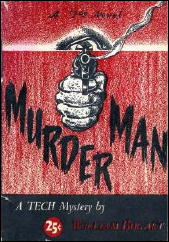
Saxon is hired by Joe Rogers, head of Rogers Publishing Company, a chain publisher of some twenty-two pulp magazines, to investigate the dubious business practices of a rival publisher, Sam Sontag.
Rogers also wants him to help persuade a love-pulpeteer who writes under the name Dulcey Dickens to sign an exclusive contract with his firm. Murder, the appearance of a racketeer named Jasper Ward, the disappearance of Dulcey Dickens, and other complications carry the narrative.
The plot isn’t particularly clever or exciting, and the solution holds no real surprises. Still, there is a certain charm to Hell on Friday (the title refers obliquely to the fact that Friday was payday for the legion of pulp writers, and often make-up day for the various magazines as well).
Saxon and Moe Martin are engaging characters (as is Dulcey Dickens), and the pulp setting is well drawn and packed with details fascinating to anyone with an interest in that vanished era. Saxon also stars in two other novels by Bogart — Murder Is Forgetful (1944) and The Queen City Murder Case (1946).
———
Reprinted with permission from 1001 Midnights, edited by Bill Pronzini & Marcia Muller and published by The Battered Silicon Dispatch Box, 2007. Copyright © 1986, 2007 by the Pronzini-Muller Family Trust.
Bibliographic Note: All three novels are available in an omnibus edition (Hell on Friday: the Johnny Saxon Trilogy) published by Altus Press, 2010).
Fri 14 Oct 2011
Posted by Steve under
Reviews[2] Comments
IT’S ABOUT CRIME, by Marvin Lachman
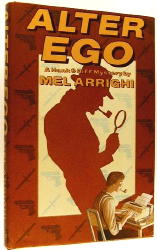
MEL ARRIGHI – Alter Ego. St. Martin’s Press, hardcover, 1983. No paperback edition. TV movie: CBS, 1987, as Murder by the Book (with Robert Hays and Catherine Mary Stewart).
There is reason to believe that Alter Ego was the projected start of a series, curtailed by the author’s death [in 1986].
It fits into the small subgenre of mysteries in which fictional characters come to life. Arrighi’s Hank Mercer writes about a tough private eye, Biff Deegan, but wants to replace him with a professor who solves his cases by cerebral methods.
Mercer attempts to convince his reluctant publisher by solving a mystery that presents itself while they are dining; a woman has dropped a matchbook on their table with a scribbled message, “Help Me!”
Aided by Biff, about whom he hallucinates, Hank gets involved in a case of art smuggling. The premise is more imaginative than its resolution, but Arrighi makes the narrative move at a brisk pace.
— Reprinted from The MYSTERY FANcier,
Vol. 12, No. 4, Fall 1990.
Thu 13 Oct 2011
A 1001 MIDNIGHTS Review
by Kathleen L. Maio
JOHN & EMERY BONETT – Dead Lion. Doubleday Crime Club, hardcover, 1949. Pocket #738, paperback, 1950. Perennial Library P563, paperback, 1982. White Circle #505, Canada, paperback, 1951 (shown). Original UK edition: M. Joseph, hardcover, 1949.
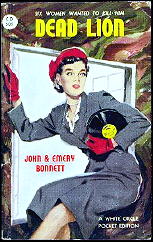
John and Felicity Carter Coulson (who write under the names John and Emery Bonett) have collaborated in a fruitful mystery career as well as a marriage. Their official joint debut came with the publication of Dead Lion, a fine example of the post-World War II British mystery.
Simon Crane comes to Britain to meet his famous uncle — critic, author, and BBC intellectual Cyprian Druse — for the first time. Instead, he finds Druse’s body, his head stuck out a window and his neck bloody and broken.
It soon becomes clear that many people wished to break Druse’s neck: the many authors he destroyed with his vitriolic criticism, and the many women he seduced, humiliated, and abandoned.
When Simon finds himself in love with one of his uncle’s embittered conquests, he no longer wishes to play sleuth. Unfortunately, Professor Mandrake does. Mandrake, an anthropologist by trade, had been a BBC colleague of Druse’s. More important, he is a natural-born busybody and student of humanity just waiting for a chance to try his hand at detecting.
While Simon tries to shield the woman he loves, Mandrake continues to happily meddle, eventually triggering the novel’s tragic conclusion.
Dead Lion is an exquisitely crafted classical mystery. But besides providing a satisfying puzzle, like its many Golden Age predecessors, this novel also features three-dimensional, modern characters with psychological quirks and motivations.
With small touches, the authors also manage to convey what life was like in England after the war. Theirs is a classic puzzle with new depth and Professor Mandrake as a lovable series sleuth.
The fat, homely professor appears in two other books — A Banner for Pegasus (1951) and No Grave for a Lady (1959). Later Bonett novels with a Spanish sleuth and Costa Brava locale are well constructed but lack the charm of the Mandrake mysteries.
———
Reprinted with permission from 1001 Midnights, edited by Bill Pronzini & Marcia Muller and published by The Battered Silicon Dispatch Box, 2007. Copyright © 1986, 2007 by the Pronzini-Muller Family Trust.
Thu 13 Oct 2011
Posted by Steve under
ReviewsNo Comments
JOHN & EMERY BONETT – Dead Lion. Doubleday Crime Club, hardcover, 1949. Pocket #738, paperback, 1950. Perennial Library P563, paperback, 1982. White Circle #505, Canada, paperback, 1951. Original UK edition: M. Joseph, hardcover, 1949.
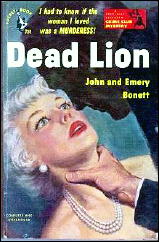
Not only is this the first case that would-be sleuth Professor Mandrake ever worked on, it’s also the first mystery written by the Bonetts (in real life, John & Felicity Coulson). Subsequent books in which Mandrake appears are A Banner For Pegasus (1951; also known as Not In The Script) and No Grave For A Lady (1960).
I say “would-be sleuth” in this case, because his attempts at solving the death of renowned (and widely hated) literary critic Cyprian Druse, while helpful, fall resoundingly flat instead. He may fare better in later cases — I hope so — but someone else will have to let us both know, since if I’ve read either one, I’ve forgotten.
The problem here is that Mandrake is working strictly at cross-purposes with the narrator, Simon Crane, the dead man’s nephew, who is the first person to realize that Cyprian’s death was murder, and not an accident, as the police believe. Crane has fallen in love with Mandrake’s chief suspect, the enigmatic but wholly enchanting Marcia Garnett, and so he does his utmost to keep the other man’s attempts at solving the case as ineffective as possible.
There is very little deduction involved. Persistence and inevitability is all that it takes to reveal the killer, even though more than half the human race would have had a motive, of sorts. What this is, far more than it is a mystery of the traditional type, is a treatise on love and romance.
Simon Crane is at once obtuse and knowing, unlikable and irresistible, and a detective like no other on record, I’m sure. There is also a great deal of tragedy and pain involved, and in the end, while justice does work its way out, it brings its share of grief as well.
It may not be obvious, even by now, so if it isn’t, I’m highly recommending this one.
Rating: A minus.
— This review was intended to appear in
Mystery*File 35. It was first published in
Deadly Pleasures, Vol. 1, No. 3, Fall 1993 (somewhat revised).
[UPDATE] 10-13-11. Even though I recommended this one at the time, I don’t remember it at all. (This comes from deliberately trying not to tell too much about the story line back in 1993.)
That it was reprinted in paperback a couple of times, however, especially later on by Perennial, suggests that my opinion was correct, that Dead Lion is indeed a better than average mystery novel from the 1940s.
To confirm this, though, I went looking, and I found a second opinion in the first place I looked: 1001 Midnights, with the review coming up next.
Thu 13 Oct 2011
Posted by Steve under
Reviews[8] Comments
THE ARMCHAIR REVIEWER
Allen J. Hubin
JOYCE PORTER – Dover and the Claret Tappers. Foul Play Press, US, hardcover, 1989. W. W. Norton, US, paperback, 1992. Originally published in the UK: Weidenfeld & Nicolson, hardcover, 1976 (shown).
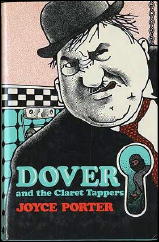
Foul Play Press has been reissuing Joyce Porter’s mysteries about England’s most stupid, lazy and unmannered copper, Inspector Wilfred Dover. They’ve come now to a 1976 title not previously published here, Dover and the Claret Tappers.
I read a few of the Dover novels earlier and recall enjoying them, but Dover’s endless incompetencies, preoccupations with stuffing his face and rushing off to lavatories when not otherwise sleeping on the job, here just get tiresome.
The caper begins when a gang calling themselves the Claret Tappers kidnaps Dover for ransom. Scotland Yard, and especially the long-suffering Sgt. MacGregor, is delighted to have him gone and refuses to pay a ha’penny.
So Dover is dumped, unharmed, and since he’s made hardly a useful observation while held, the case eventually goes to the back burner. But not for good, because the Tappers aren’t done yet…
— Reprinted from The MYSTERY FANcier,
Vol. 12, No. 4, Fall 1990.
Editorial Comment: If you are thinking what I think you’re thing, that that’s one ugly cover, I agree with you 100 percent. It’s no wonder that it wasn’t used in the US edition. But the latter was barely more than plain text on the front. Boring!
Wed 12 Oct 2011
ABANDONED. Universal International Pictures, 1949. Dennis O’Keefe, Gale Storm, Marjorie Rambeau, Raymond Burr, Will Kuluva, Jeff Chandler, Meg Randall, Jeanette Nolan, Mike Mazurki. Director: Joseph M. Newman.
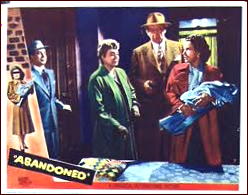
Dennis O’Keefe makes for a good newpaper reporter in Abandoned, and Raymond Burr makes an even better private eye, one definitely on the shady side. Before he became Perry Mason and famous, as we’ve said before on this blog, he was best known for his villainous roles in cheap crime dramas, albeit often weak and shifty ones. His part in this movie, in other words, was tailor made for him.
So what this is, as you may have guessed, is a cheap crime drama, but is it noir, as it’s often advertised as being? Not with Gale Storm in the leading role, even though the movie’s in black and white, with lots of noirish lighting and noirish dialogue.
As the sister who died trying to regain her baby from a gang specializing in illegal baby adoptions, calling on Dennis O’Keefe for help, she’s too giggly and perky for the part (think My Little Margie). The ending, after a lot of gunfire and fatal automobile accidents, is also too upbeat for Abandoned to really fall into the noir category.
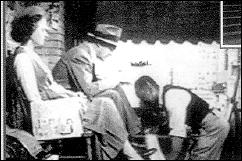
But it comes close, indeed it does. And if the entire script had been part of the movie, if as I have a feeling it wasn’t, it would have been a whole lot closer.
Unanswered by the movie I saw is the question of the two girls’ father, who hired Raymond Burr (the shady PI) in the first place, and the connection with the baby racketeers, whom Burr works for as well.
And I’m sure I remember a scene in which Gale Storm’s character tells O’Keefe (the reporter) that the reason her sister left home and headed for LA, was because their father wouldn’t leave either one of them alone.
Neither of these two threads of the story line is followed up on, but at the time this movie was made, all they could probably do is leave hints.
« Previous Page — Next Page »



